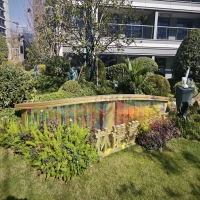Welcome to the website for landscape facilities products and knowledge.
What are the environmental impacts of producing landscape tables from different materials?
The production of landscape tables involves a variety of materials, each with distinct environmental implications. Understanding these impacts can help consumers make sustainable choices for outdoor furniture.
1. Wooden Landscape Tables
Wood is a popular choice due to its natural aesthetic, but its environmental footprint depends on sourcing. Sustainably harvested timber, such as FSC-certified wood, minimizes deforestation and promotes biodiversity. However, untreated wood may require chemical preservatives, which can leach into the soil.
2. Metal Tables (Aluminum, Steel)
Metal tables, particularly those made from recycled aluminum, are durable and long-lasting. While aluminum production is energy-intensive, recycling reduces its carbon footprint. Steel, though sturdy, often involves high emissions during manufacturing. Powder-coated finishes can mitigate rust but may contain harmful chemicals.
3. Recycled Plastic Tables
Recycled plastic tables repurpose waste, reducing landfill burden. However, the recycling process consumes energy, and some plastics may degrade over time, releasing microplastics. Look for high-density polyethylene (HDPE) for better durability.
4. Concrete Tables
Concrete is robust but has a high carbon footprint due to cement production. Innovations like fly ash or recycled aggregates can lower its environmental impact. Heavyweight also increases transportation emissions.
5. Composite Materials
Composite materials blend wood fibers and plastics, offering durability with reduced maintenance. However, they often contain non-recyclable components, complicating end-of-life disposal.
Conclusion
Choosing eco-friendly landscape tables involves balancing aesthetics, durability, and sustainability. Opt for certified wood, recycled metals, or responsibly sourced composites to minimize environmental harm. Prioritizing longevity and recyclability ensures a greener outdoor space.
Related search:

Recommendation
Metal and acrylic color-changing combined curtain wall for large-scale public landscape facilities